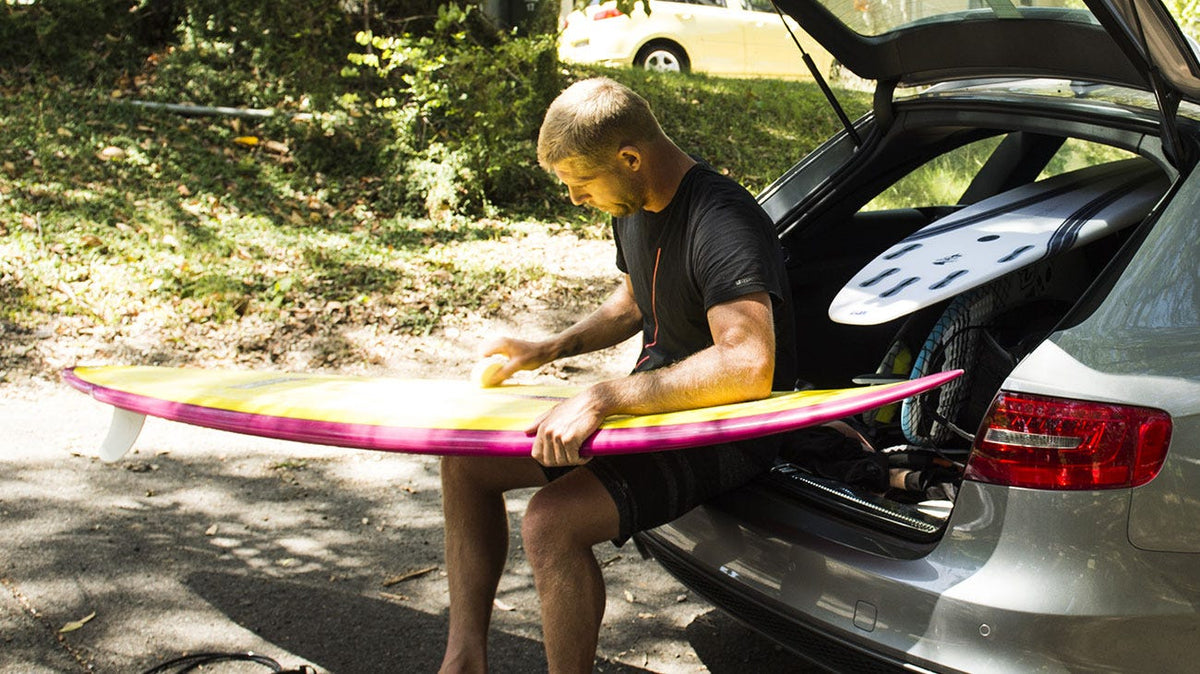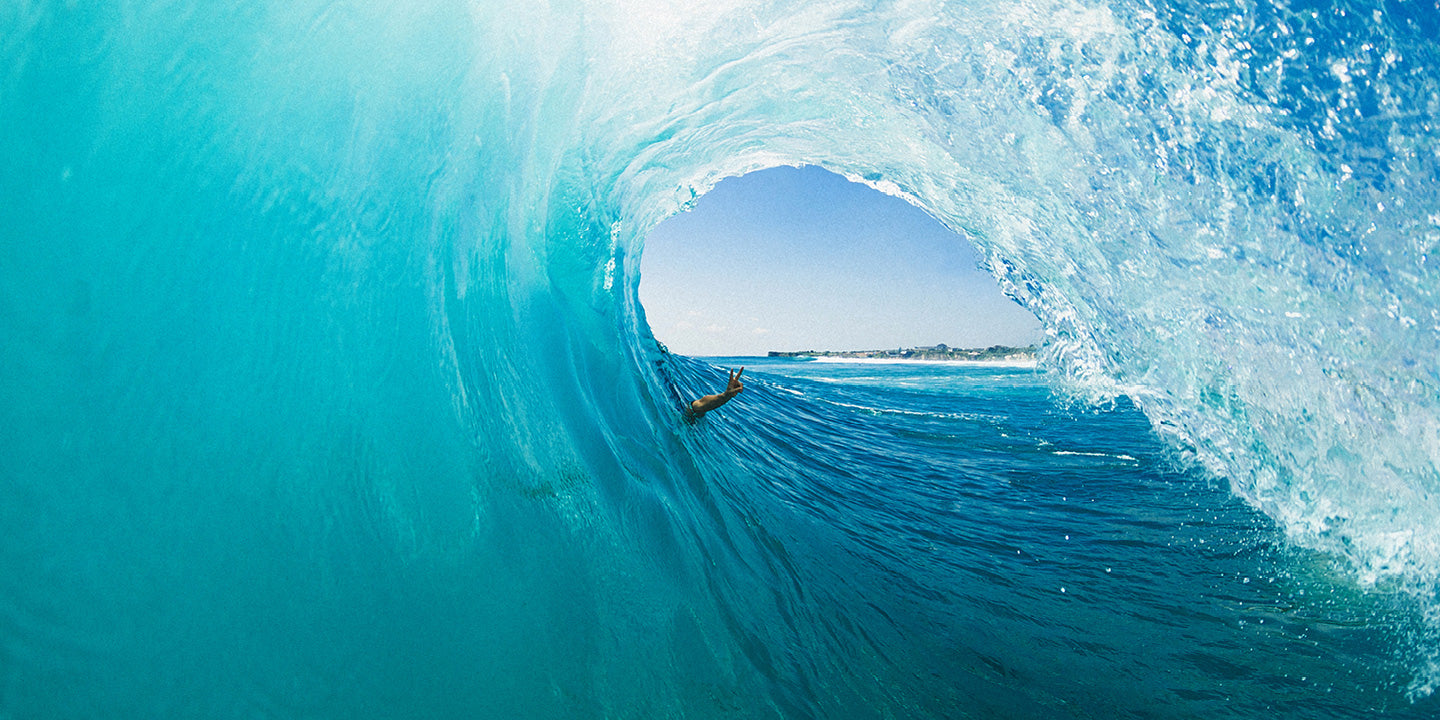Guide Pratique pour Waxer Sa Planche : Étapes, Astuces et Conseils

Wax is an essential element for every surfer. Not only does it improve grip on the board, but it also enhances your performance by helping you stay stable. In this article, we provide you with a detailed guide on how to wax your surfboard properly, while maximizing your grip on the board. In addition, we’ll explain which wax to choose depending on the water temperature.
How to wax your board to improve performance?
What is surf wax used for?
During a surf session, the surfer stands on the board, but to do so, wax is necessary. Surf wax is essential in order to place your feet on the board and stand up without slipping. This wax helps maintain good balance, a crucial condition for performing maneuvers and catching waves with ease. In other words, wax allows you to stand up without risking a fall. Imagine being on a board without wax: you would constantly slip, making any maneuver impossible. It would be a shame to fall because poorly applied or missing wax could ruin a session.

The consequences of a poorly waxed board
A poorly waxed board seriously compromises your performance. If the wax is unevenly applied or not suited to the conditions, it becomes ineffective and can cause frequent falls. Without proper grip, wax softens in higher temperatures, while in colder conditions it hardens and may not provide the required flexibility. Furthermore, poor application on the rails or the nose of the board can affect your turns and make the board harder to control. A poorly waxed board can turn a promising session into a series of avoidable wipeouts.
Which wax to choose according to conditions?
Understanding the importance of water temperature
The choice of wax depends mainly on the water temperature in which you will be surfing. A warm-water wax will melt much faster, while a cold-water wax will remain hard even at low temperatures. That’s why it’s crucial to know the water type, meaning the temperature in which you will surf. If you surf in warm waters with wax designed for cold temperatures, it could melt much faster, becoming soft and losing its effectiveness. Knowing the water temperature is essential to choosing your wax correctly and ensuring good grip.
Types of wax: tropical, cold water, warm water and base coat
There are several types of wax depending on the climatic conditions, so it’s important to choose wisely:
- Tropical: For waters above 26°C.
- Warm water: For waters between 18°C and 24°C.
- Cool/temperate water: For waters between 14°C and 23°C.
- Cold water: For waters below 15°C.
Additionally, it is recommended to apply a base coat, an underlayer that creates a sticky surface for the wax to adhere to. This product is essential to make your board ready for any condition.
The wetsuit as a wax ally for performance
Choosing the right wax is one thing, but finding the right thickness of wetsuit is another. For cold winter waters, we recommend a 4/3mm or 5/4mm wetsuit, and when spring arrives, a 3/2mm will do the job perfectly!

Preparing your board before waxing
Cleaning and de-waxing: essential prerequisites
Before applying wax, it’s crucial to thoroughly clean the board and remove old wax. Use a wax comb or a cloth soaked in mineral spirits to remove residue that could affect grip. It would be a shame to fall because you didn’t properly prepare the surface of your board.
Assessing the condition of the board
Once the board is clean, check its condition. Make sure there is no leftover wax or other defects on the surface. A well-maintained board ensures better performance and optimal grip.
The waxing process step by step
Apply the base coat: techniques and tips
Start by applying a thin layer of base coat using circular motions on the top part of the surfboard. This ensures that the wax adheres better, especially in colder waters where wax tends to be harder. This step is key, as wax allows you to stick your feet effectively to the board.
How to wax your surfboard for grip? Recommended method and pattern
Once the base coat is applied, spread the wax in small circles, while others prefer crisscross patterns. This helps distribute the wax more evenly for maximum grip. Make sure the areas where your feet are placed on the board have consistent grip to optimize performance. By following this method, you can place your feet more securely. For longboards, you may also wax the entire board since you might walk all the way to the nose to perform maneuvers.
Checks and final touch-ups
Before heading into the water, check that the wax sticks well to the board. If needed, add a few more strokes of wax to ensure good grip. Don’t forget to check carefully the areas where you will place your feet, as they are the most stressed.

When and how to re-wax your surfboard?
Identifying the signs your board needs re-waxing
When the wax starts to deteriorate or becomes soft in high temperatures, it’s time to reapply. If your feet begin to slip, that’s an obvious sign your board needs a new layer of wax. Always make sure the wax is in good condition to avoid losing grip.
Recommended frequency of re-waxing
In general, it’s recommended to re-wax your board after several sessions or when you notice the surface losing its stickiness. If you surf often, you may need to re-wax more frequently, especially in conditions where wax melts quickly.
Common mistakes to avoid when waxing
Using the wrong type of wax
Choosing the right wax is essential. Using warm-water wax in cold water will not give you the grip you need. Conversely, cold-water wax will melt too quickly in warm water, causing you to lose grip within minutes. It is therefore essential to know what type of water you will be surfing in.
Excessive or insufficient waxing
Too much wax can make the board heavier and affect your maneuvers. Too little wax reduces grip and increases the risk of slipping. Finding the right balance is key for optimal results.
Alternatives to traditional wax. Which wax to choose?
Traction pads: pros and cons
Traction pads are an interesting alternative to wax. They provide long-lasting grip without constant reapplication, but they may lack flexibility and aren’t always suited to every board.
Eco-friendly wax and innovations
With growing environmental concerns, many eco-friendly alternatives such as Sticky Bumps, which has the advantage of extra stickiness, and Sex Wax, are becoming increasingly popular. These biodegradable waxes are more ocean-friendly while maintaining good grip. Which wax to choose among these innovations? It depends on your preferences and ecological values.
We also sell our organic surf wax in Rip Curl stores. Made from a blend of renewable high-performance ingredients, it is packaged with 100% recycled materials.
Conclusion
Learning how to wax your board correctly is essential to maximize your performance. By choosing wax suited to the temperature, carefully applying a base coat, and regularly checking the wax condition, you’ll ensure optimal grip. It would be a shame to fall because the wax was not properly applied or chosen. Also, consider exploring alternatives such as Sticky Bumps or Sex Wax for a more eco-friendly surf. Which wax to choose is a crucial decision to ensure you can place your feet securely on the surfboard.
Ready to surf with a well-waxed board?



